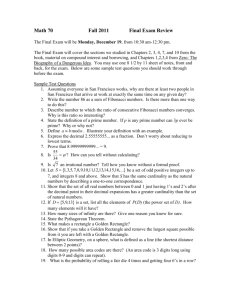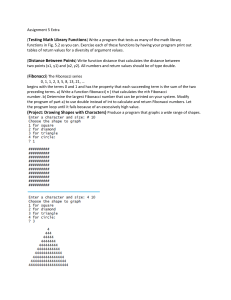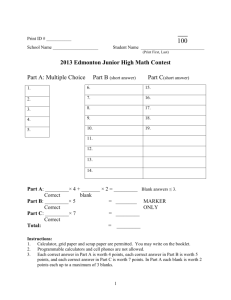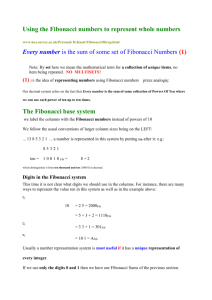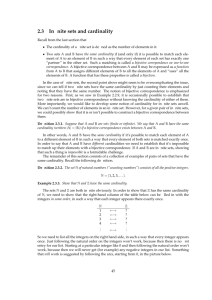Final Exam Review Sheet
advertisement
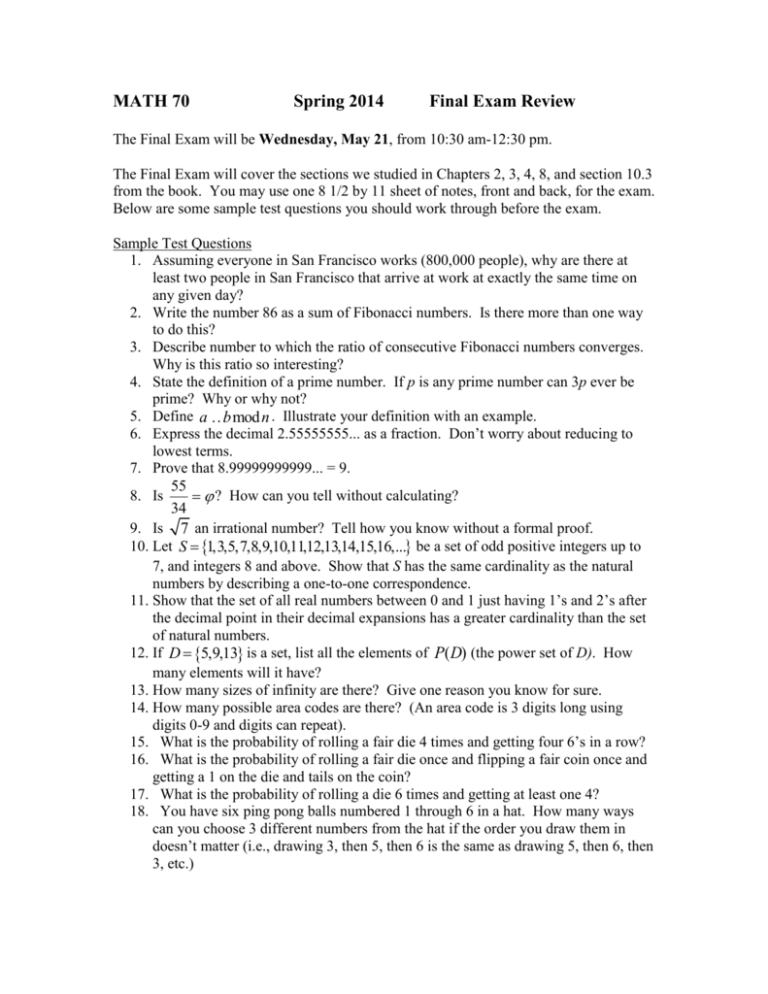
MATH 70
Spring 2014
Final Exam Review
The Final Exam will be Wednesday, May 21, from 10:30 am-12:30 pm.
The Final Exam will cover the sections we studied in Chapters 2, 3, 4, 8, and section 10.3
from the book. You may use one 8 1/2 by 11 sheet of notes, front and back, for the exam.
Below are some sample test questions you should work through before the exam.
Sample Test Questions
1. Assuming everyone in San Francisco works (800,000 people), why are there at
least two people in San Francisco that arrive at work at exactly the same time on
any given day?
2. Write the number 86 as a sum of Fibonacci numbers. Is there more than one way
to do this?
3. Describe number to which the ratio of consecutive Fibonacci numbers converges.
Why is this ratio so interesting?
4. State the definition of a prime number. If p is any prime number can 3p ever be
prime? Why or why not?
5. Define a º bmodn . Illustrate your definition with an example.
6. Express the decimal 2.55555555... as a fraction. Don’t worry about reducing to
lowest terms.
7. Prove that 8.99999999999... = 9.
55
8. Is
= j ? How can you tell without calculating?
34
9. Is 7 an irrational number? Tell how you know without a formal proof.
10. Let S = {1,3,5,7,8,9,10,11,12,13,14,15,16,...} be a set of odd positive integers up to
7, and integers 8 and above. Show that S has the same cardinality as the natural
numbers by describing a one-to-one correspondence.
11. Show that the set of all real numbers between 0 and 1 just having 1’s and 2’s after
the decimal point in their decimal expansions has a greater cardinality than the set
of natural numbers.
12. If D = {5,9,13} is a set, list all the elements of P(D) (the power set of D). How
many elements will it have?
13. How many sizes of infinity are there? Give one reason you know for sure.
14. How many possible area codes are there? (An area code is 3 digits long using
digits 0-9 and digits can repeat).
15. What is the probability of rolling a fair die 4 times and getting four 6’s in a row?
16. What is the probability of rolling a fair die once and flipping a fair coin once and
getting a 1 on the die and tails on the coin?
17. What is the probability of rolling a die 6 times and getting at least one 4?
18. You have six ping pong balls numbered 1 through 6 in a hat. How many ways
can you choose 3 different numbers from the hat if the order you draw them in
doesn’t matter (i.e., drawing 3, then 5, then 6 is the same as drawing 5, then 6, then
3, etc.)
19. An investment is worth 500i1.05t dollars after t years. What was the initial
investment? What was the annual interest rate?
20. After 3 years, how much money will be in an account that has an interest rate of
3.5% compounded monthly if the initial deposit is $600?
21. Your subsidized student loan rate is 7% compounded monthly. If you borrow
$10,000, what will your monthly payment be if it takes you 10 years to pay it
back? How much do you end up paying over the 10 years?
Answers to Sample Test Questions
1. There are about 800,000 people who live in San Francisco. There are only 86,400
seconds in a day. By the Pigeonhole Principle, at least 2 of these people must
arrive at work at exactly the same second.
2. 86 = 55 + 21 + 8 + 2. There are different ways to write 86 as a sum of Fibonacci
numbers, but only one way to write it as a sum of non-consecutive Fibonacci
numbers.
3. The ratio of consecutive Fibonacci numbers converges to j (“phi”).
1+ 5
» 1.618... . Phi is interesting because it shows up in nature, art,
2
architecture and many other places.
4. A prime number is any number greater than 1 that has only 1 and itself as factors.
3p can never be prime because it will always have 1, 3 and itself as factors. This
violates the definition of prime.
5. a º bmodn means that a is the remainder when we divide b by n. Examples
vary.
23
6.
9
m = 8.99999....
10m = 89.99999...
7.
9m = 81
m=9
8.99999.... = 9
55
55
8.
is a rational number and j is irrational.
¹ j . We can tell because
34
34
9. Yes, 7 is irrational. We know because we know that the square root of any
integer that is not a perfect square is an irrational number.
10. If n Î N, for n £ 4 we have the correspondence n ®2n -1Î S. For n ³ 5 we
have the correspondence n ® n + 3 Î S.
11. List all the numbers in the set so that every natural number corresponds to a
number on the list. Then, we can create a number, M. that is not on the list by
changing the digit in the first decimal place of the first number, the digit in the
second place of the second number, the digit in the third decimal place of the third
number and so on so that M is different than every number on the list. So, we
j=
have a number in the set not on the list, hence it doesn’t correspond to a natural
number. So, we don’t have a one-to-one correspondence with the natural
numbers and our set. Hence the cardinality of the set is bigger than the cardinality
of the natural numbers.
12. P(D) = {{5},{9},{13},{5,9},{5,13},{9,13},{5,9,13},{ }}. There are 23 = 8 elements
in P(D).
13. There are infinite sizes of infinity. We know because a power set of a set always
has more elements than the set itself. So, if we take the power set of the natural
numbers, we get a set of infinite elements bigger than the infinity of the natural
numbers. Then, if we take the power set of the power set of the natural numbers
we get a set of infinite elements still bigger. We can keep taking power sets
infinitely many times.
14. There are 1000 possible area codes.
1
15.
1296
1
16.
12
6
31031
æ 5ö
17. 1 - ç ÷ =
» 66.5%
è 6ø
46656
6i5i4
18.
= 20 ways
3i2i1
19. Initial investment is $500. The annual interest rate is 5%.
20. $666.33
21. $116.11 per month. Pay $13933.20 total over 10 years.
